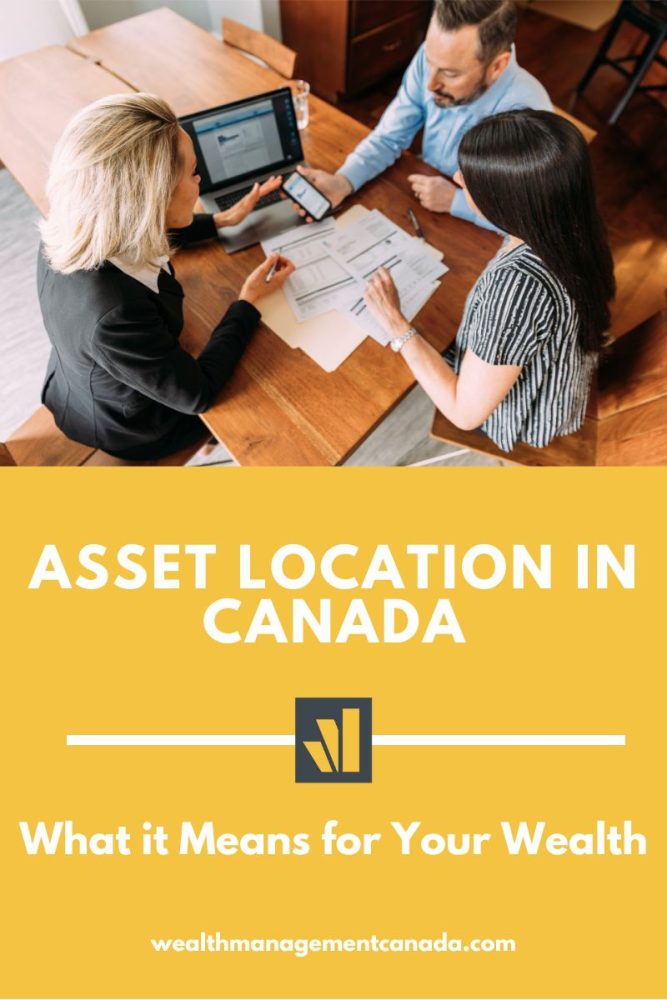As a beginner or seasoned investor in Canada, you may have come across the term “asset allocation“. It’s a common strategy used when investing. It allows you to balance your portfolio and minimize risks by spreading your investment across various categories. By optimizing these categories, you can better manage risk, returns and the achievement of financial goals. However, did you know there’s an asset placement strategy that lets you optimize your tax liabilities and returns too? It’s called “asset location“. Many people often confused asset allocation and asset location, but they are indeed different investing strategies. Asset location in Canada helps you save money by readjusting your assets in the right accounts. In other words, asset location focuses on where your investments actually reside, such as in a non-registered versus registered account, with the intention of minimizing tax on returns.

Table of contents

START WORKING WITH A WEALTH MANAGER NOW
Let’s learn more about this topic below. We’ll share some important points that will help you make the most of your investments. Keep reading to learn more!
What is the asset location theory?
Asset location theory is a tax optimization strategy. It aims to take advantage of different types of investments with unique tax treatments to minimize overall tax paid. The theory considers both the type of investment and it’s corresponding tax treatment, as well as what account it’s held within. Asset location theory can vary by country as well. This is because the tax treatment of investment income varies based on local taxation laws.
What is asset location in Canada?
Asset location in Canada is an investing strategy used to improve your portfolio’s tax efficiency by distributing your assets across various investment accounts. Asset location focuses on where your investments and assets are placed, may that be in a TFSA, RRSP or non-registered account. Whereas asset allocation focuses on the percentage invested in each specific category, such as bonds, ETFs, stocks, or even high versus low risk investments. To summarize, asset location is the way you allocate your assets across various investment and tax-advantaged accounts to maximize your after-tax returns.
What account types does asset location consider?
Asset location comes into play when an investor begins to diversify and hold investments in RRSP, TFSA, and other investment accounts. If you’ve only just begun your investing journey, it may be too soon to consider asset location. Most Canadians tend to max out their RRSP, TFSA and other registered accounts before opening a non-registered account. But when your portfolio gets this big, it’ll be time to consider asset location to ensure your investments are placed in the best spot to minimize tax. As an investor with a healthy portfolio, you’ll need to decide which assets go into which account based on incomes generated and the corresponding taxation. This is because returns on interests, capital gains, and interests are taxed uniquely depending on where they’re located account wise and Canadian tax laws.
More specifically, in Canada, there are three basic investment account types, each with a unique taxation system. There’s the Registered Retirement Savings Plan (RRSP), Tax-free Savings Account (TFSA), and the non-registered investment account, which we will focus on in this article. You may have access to other specialized accounts too, such as the Registered Disability Savings Plan (RDSP) or a Registered Education Savings Plan (RESP). These should be considered as a part of your asset location strategy as well. But for the simplicity of this article, we’ll be focusing on the core three investments accounts. Should you need advice on how to manage your wide portfolio, consider reaching out to a wealth manager for support with your asset location strategy.
Related Reading: Is the Longest Bull Market Over?
What are the benefits of asset location?
The main objective of asset location in Canada is tax optimization. This means reducing tax liabilities and increasing tax returns wherever possible. Investors attempt to place their assets in accounts that will optimize the tax benefits of each account based on the particular returns of each investment. For example, an RRSP is a tax-deferred account, meaning that investment growth is tax-free until withdrawal. An investor may choose to place high yield investments into an RRSP, as opposed to other accounts, to defer tax and control their specific tax bracket upon retirement.
Ultimately, the biggest benefit of asset location is reducing taxes so your after-tax investment profits are as high as possible. Here are other scenarios where asset location will benefit you as an investor:
- Reduce taxes when in the highest tax bracket. If you’re in the highest tax bracket, asset location matters more than if you’re in a lower tax bracket. You can significantly reduce your taxes by using asset location.
- Prepare for rising tax rates. Canada is known for high taxation. In addition, Canada operates under a tax system that redistributes wealth. This means that those in the higher tax brackets are taxed more than the lower counterparts. For this reason, tax hikes and new tax regulations can cause waves in your portfolio and wealth. But if your portfolios are already optimized using asset location, then these tax surprises won’t hit as hard.
- Using both tax-advantaged and taxable accounts. Usually asset location is only useful when you’ve maxed out your RRSP and TFSA, then you’ve opened a taxable account for further investments. If this is the case, definitely consider asset location to optimize your after-tax returns.

START WORKING WITH A WEALTH MANAGER NOW
What are the drawbacks of asset location?
Asset location in Canada does have a few drawbacks, particularly due to the complex nature of the strategy. Let’s take a closer look below.
- Complex process. First, investors need to decide what the ideal location of each asset is. Then, you’ll need to do all the paperwork to actually transfer and move around assets from one account to another. It can be a lot of work to put your asset location strategy in motion, especially if you are not familiar with tax laws, how investments are taxed, and the administration of investment accounts. Fortunately, wealth managers can help with this.
- Fees and penalties. When you move investments from one account to another, fees may arise. Fortunately, most of these fees are only incurred once to process the transfer or purchase and sale, so consider it a one time cost to optimize your future returns. However, if you don’t know what you’re doing, you might end up paying unnecessary fees. Further, you might incur severe penalties if you violate the rules of registered accounts, such as withdrawing from a RRSP before retirement.
- Only helps investors with large portfolios. Beginner investors should understand the fundamentals of asset location as they grow their portfolios. After all, if you can place assets in the right place from the get-go, then you won’t have to readjust your portfolio down the road. However, only seasoned investors with large portfolios consisting of both taxable and non-taxable accounts truly benefit from asset allocation. This is because they have more money to move around and optimize their tax burden.
Related Reading: A Closer Look at the State of Canada’s Housing Market
What is the proper asset location?
When it comes to asset location, there are no hard and fast rules. At the end of the day, you will need to devise a unique strategy for your portfolio based on your investment types, tax situation, and other aspects of your personal finances. But here are some general rules of thumb when beginning your asset location journey:
Place high dividend yield stocks and other investments in taxable accounts
Dividends from stocks have favorable tax treatment, whether they’re domestic or foreign. Generally, they are eligible for the dividend tax credit (or the foreign dividend tax credit) which is tax advantageous compared to other investment income types. For this reason, it’s best to place stocks and other investments with high dividend yields in taxable accounts so you can take advantage of the dividend tax credit. Typically, this reduces your overall tax burden.
However, if you’re still new to investing, you may want to avoid tax on dividends altogether. If this is the case, place these high yield dividend investments in a TFSA, RRSP or other registered account.
Place high growth investments in TFSAs, RRSPs or other registered accounts
High growth investments typically yield a large capital gain when you decide to sell them. The larger the gain, the larger your tax burden will be. For this reason, it’s best to hold these high growth investments in registered accounts that shelter or defer tax. The only drawback here is that you cannot apply capital losses against capital gains within a registered account. So, if you want to utilize potential capital losses against capital gains, then consider holding high growth investments within a taxable account instead to optimize your taxes.
Place investments that yield interest income in TFSAs, RRSPs or other registered accounts
Interest income is not taxed favorably in Canada. The full amount is taxable at your marginal rate and there is no corresponding tax credit like we saw above with dividends. To minimize taxes on interest yielding investments, place them in TFSAs, RRSPs and other registered accounts.
As for foreign interest, there is usually no benefit to holding them within a TFSA, RRSP or other registered account, unless it’s US interest income. Ultimately, where you place foreign interest yielding investments will depend on the specific tax laws surrounding where the investment is held. From there, you can decided what the best asset location is.
Related Reading: Passive Investing in Canada
Is asset location worth it?
Yes! Asset location is a worthwhile practice, especially for those who have maxed their TFSA and RRSP and have begun investing within non-registered accounts too. However, if you’re beginning your investing journey, understanding the logic behind asset location in Canada can help you grow your wealth smarter. For instance, you can only buy investments within your TFSA and RRSP that optimize your taxes, then expand into other investments once you’ve maxed your accounts and opened a non-registered account.
Not sure how to devise and employ your asset location strategy in Canada? A wealth manager can help. Find one today!
Read More: Considerations for Canadian Investors: Year-End Tax Tips